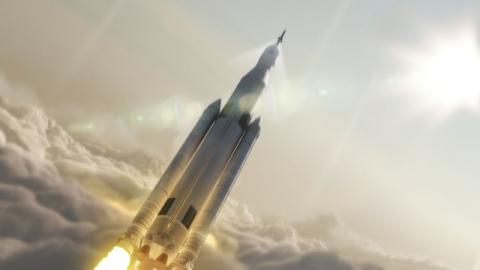NASA’s Space Launch System is officially all systems go for Mars and Moon landings
The Space Launch System is broken up into blocks. Block I, the first and most simple design, consists of a core stage that’s lifted almost straight from the Space Shuttle: It has two Space Shuttle Solid Rocket Boosters (SSRBs), and a first stage that’s fashioned out of a converted Space Shuttle External Tank (that big red cylinder thing — but on the SLS it’ll be painted white). Together with a modified Delta Cryogenic Second Stage (modified from the Delta IV), Block I will be able to lift around 70 metric tons (154,000 lbs) into low-Earth orbit. There is only expected to be one launch of the Block I variant. If all goes to plan, it will launch sometime in 2017 or 2018 and send an uncrewed Orion capsule on a circumlunar orbit around the dark side of the Moon.
The next variant of the SLS, Block IB, will use the same core stage as Block I — but instead of the modified Delta IV second stage, it’ll have the brand-new Exploration Upper Stage. The EUS has a lot of fuel and four RL10 rocket engines, boosting the total payload capacity to around 110 metric tons to LEO. Finally, at some point in the 2030s, Block II will arrive, which replaces the two SSRBs with new, “advanced boosters.” Block II will be capable of lifting around 155 metric tons to LEO.
By comparison, the Saturn V — which took NASA astronauts to the Moon — had a max LEO payload capacity of 118 metric tons, but it has long since been retired. SpaceX’s Falcon Heavy, which is a much smaller and cheaper rocket than the SLS, will be able to put 55 metric tons into LEO. With the retirement of the Space Shuttle, there aren’t really any heavy lift launchers in operation: Ariane 5 (Arianespace) can only do 21 metric tons to LEO, while Delta IV (United Launch Alliance) can do 29 metric tons to LEO.
In short, NASA’s Space Launch System should be by far the most powerful operational rocket when it arrives in 2017-2018. SpaceX could decide to up-rate the Falcon Heavy, but I doubt it: With Falcon Heavy, SpaceX wants to compete with United Launch Alliance and Arianespace, which currently own the (incredibly lucrative) heavy lift market. A payload capacity of 55 tons is more than enough for that purpose. You only shoot for a capacity of 150 tons if you’re aiming at targets that are much farther than geostationary orbit — such as landing on the Moon or Mars or Europa.
The SLS’s primary payload will be the Orion Multi-Purpose Crew Vehicle (MPCV), though it will undoubtedly be used to send other large spacecraft into deep space. The Orion capsule is what NASA will use to land astronauts on the Moon, captured asteroids, Mars, and any other interesting lumps of rock throughout the Solar System. The first manned Orion launch, to a captured asteroid in lunar orbit, is scheduled to occur in 2021. Combined with SpaceX’s crewed Dragon spacecraft and Boeing’s CST-100, things are looking up for human space exploration!
Sebastian Anthony

